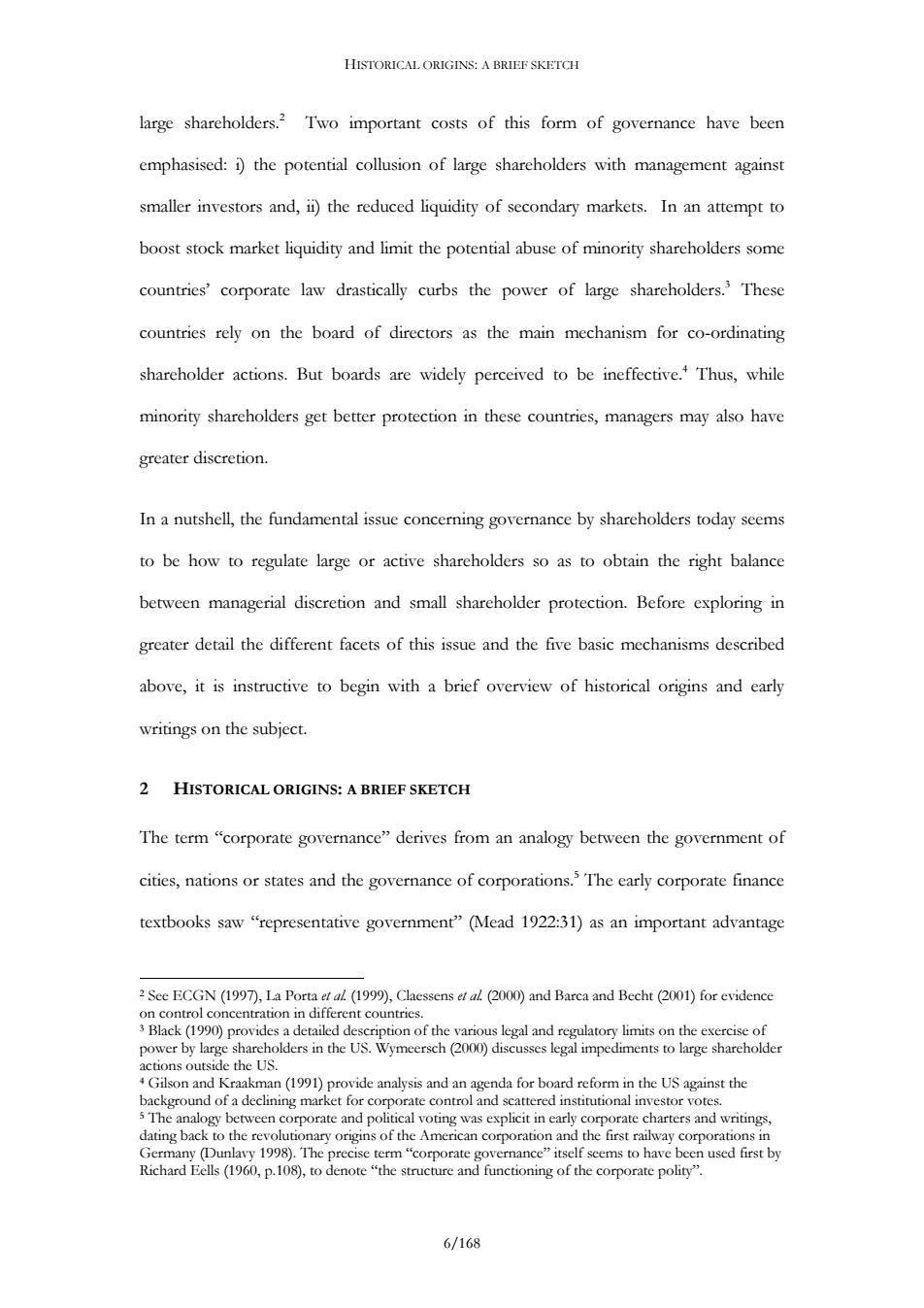正在加载图片...

HISTORICAL ORIGINS:A BRIEF SKETCH large shareholders.?Two important costs of this form of governance have been emphasised:i)the potential collusion of large shareholders with management against smaller investors and,ii)the reduced liquidity of secondary markets.In an attempt to boost stock market liquidity and limit the potential abuse of minority shareholders some countries'corporate law drastically curbs the power of large shareholders.3 These countries rely on the board of directors as the main mechanism for co-ordinating shareholder actions.But boards are widely perceived to be ineffective.Thus,while minority shareholders get better protection in these countries,managers may also have greater discretion. In a nutshell,the fundamental issue concerning governance by shareholders today seems to be how to regulate large or active shareholders so as to obtain the right balance between managerial discretion and small shareholder protection.Before exploring in greater detail the different facets of this issue and the five basic mechanisms described above,it is instructive to begin with a brief overview of historical origins and early writings on the subject. 2 HISTORICAL ORIGINS:A BRIEF SKETCH The term "corporate governance"derives from an analogy between the government of cities,nations or states and the governance of corporations.The early corporate finance textbooks saw "representative government"(Mead 1922:31)as an important advantage 2 See ECGN (1997),La Porta etal (1999),Claessens etal(2000)and Barca and Becht(2001)for evidence on control concentration in different countries. 3 Black(1990)provides a detailed description of the various legal and regulatory limits on the exercise of power by large shareholders in the US.Wymeersch(2000)discusses legal impediments to large shareholder actions outside the US. 4 Gilson and Kraakman(1991)provide analysis and an agenda for board reform in the US against the background of a declining market for corporate control and scattered institutional investor votes. 5The analogy between corporate and political voting was explicit in early corporate charters and writings, dating back to the revolutionary origins of the American corporation and the first railway corporations in Germany (Dunlavy 1998).The precise term"corporate governance"itself seems to have been used first by Richard Eells (1960,p.108),to denote "the structure and functioning of the corporate polity". 6/168HISTORICAL ORIGINS: A BRIEF SKETCH large shareholders.2 Two important costs of this form of governance have been emphasised: i) the potential collusion of large shareholders with management against smaller investors and, ii) the reduced liquidity of secondary markets. In an attempt to boost stock market liquidity and limit the potential abuse of minority shareholders some countries’ corporate law drastically curbs the power of large shareholders.3 These countries rely on the board of directors as the main mechanism for co-ordinating shareholder actions. But boards are widely perceived to be ineffective.4 Thus, while minority shareholders get better protection in these countries, managers may also have greater discretion. In a nutshell, the fundamental issue concerning governance by shareholders today seems to be how to regulate large or active shareholders so as to obtain the right balance between managerial discretion and small shareholder protection. Before exploring in greater detail the different facets of this issue and the five basic mechanisms described above, it is instructive to begin with a brief overview of historical origins and early writings on the subject. 2 HISTORICAL ORIGINS: A BRIEF SKETCH The term “corporate governance” derives from an analogy between the government of cities, nations or states and the governance of corporations.5 The early corporate finance textbooks saw “representative government” (Mead 1922:31) as an important advantage 2 See ECGN (1997), La Porta et al. (1999), Claessens et al. (2000) and Barca and Becht (2001) for evidence on control concentration in different countries. 3 Black (1990) provides a detailed description of the various legal and regulatory limits on the exercise of power by large shareholders in the US. Wymeersch (2000) discusses legal impediments to large shareholder actions outside the US. 4 Gilson and Kraakman (1991) provide analysis and an agenda for board reform in the US against the background of a declining market for corporate control and scattered institutional investor votes. 5 The analogy between corporate and political voting was explicit in early corporate charters and writings, dating back to the revolutionary origins of the American corporation and the first railway corporations in Germany (Dunlavy 1998). The precise term “corporate governance” itself seems to have been used first by Richard Eells (1960, p.108), to denote “the structure and functioning of the corporate polity”. 6/168